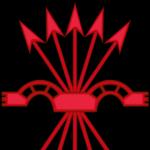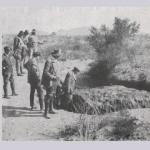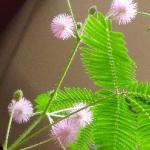Growing bonsai is constant discoveries, discoveries and creative work that makes a person truly happy. And to achieve this effect, you need to know the methods and some features of growing bonsai. In order to grow a bonsai according to all the rules, you need special dishes, tools, special care, etc. etc. In this article I will talk directly about the growing process.
Bonsai from Sargent's Juniper. Age 15 years. Han-Kengai style. © Cliff
Choosing plants for bonsai in a nursery
Young plants purchased from a nursery can be used to form beautiful bonsai relatively quickly. Most plants sold in nurseries are grown in containers for many years. Due to this, they tend to develop a well-formed and dense root system, which is ideal for bonsai formation.
The plant is removed from the container, the old soil is removed and the roots are first pruned to obtain root system flat shape. After this, the plant is planted again in a regular container, now filled with soil mixture for bonsai. Very soon, such plants can already be transplanted into low special containers (bowls).
The only thing that needs to be remembered when carrying out severe root pruning is observing the correct timing of planting, in other words, all these activities are carried out at the end of winter, before the period has yet begun. active growth.
The range of plants sold in nurseries is very large, and it is easy to get confused. That is why in the nursery it is best to thoroughly review all the available plants and try to find the most suitable specimens for the formation of bonsai. In addition, it is worth regularly visiting gardening centers and nurseries and looking into the farthest corners there, where there may be prematurely aged dwarf trees.
True, beginners are advised to select younger plants, from which it is easier to form a bonsai. The choice of plants must be approached very critically. Trees intended for the formation of bonsai must be densely branched right down to the ground, so that after pruning they can be left suitable for various styles branches.
When inspecting plants, the soil around the trunk must be slightly excavated in order to be able to clearly examine the base of the trunk. Grafted plants should be grafted in such a way that the grafting site is not noticeable in the formed bonsai.
Particular care is required when purchasing plants with a very dense crown, the inside of which is usually completely bare. Such plants require a very long time to grow. inside new shoots appeared on the branches. This concerns mainly large specimens of common spruce (Picea abies) “Pumila Glauca” and gray spruce (Picea glauca) “Conica”.
Rhododendrons with a spherical crown are more suitable because they produce young shoots relatively quickly. old wood. For the formation of bonsai, we can safely recommend all low-growing forms and varieties of pine, non-grafted fan maples, field maple, all types of barberry, local species of elms, non-grafted common hornbeam, dwarf pine (dwarf pine), juniper, hawthorn and many others.
 Bonsai. Composition of several trees. © Sage Ross
Bonsai. Composition of several trees. © Sage Ross Collectors who have the necessary experience and prefer plants that are difficult to form and expensive can only be advised to look for suitable source material in nurseries. Since bonsai became known in Germany, the first nurseries also appeared, which, along with the usual assortment, began to grow trees intended for bonsai formation.
Now they have good choice suitable and very inexpensive plants, which after a couple of years of work can turn into very beautiful and very valuable bonsai. Therefore, plants from nurseries are the best way to learn how to form bonsai.
Bonsai taken from nature - Yamadori
There are beautiful trees in nature that, despite their age, are excellent for forming bonsai. Mostly, high in the mountains, on the borders of forests, you can find century-old trees that do not exceed 50 cm in height. A very short growing season allows plants to grow only a few millimeters per year. Due to constant strong winds, ice and snow storms, they remain dwarf and acquire a bizarre, often very curved shape.
In order to dig up plants in nature, you must obtain permission from the landowner. When digging up a plant, a seedling is replanted in its place, if possible. In order for such source material To form a harmonious bonsai, you must have the appropriate experience. First of all, it can be very difficult for new bonsai enthusiasts to make something decent out of this intertwined, tangled and abstractly shaped material. That is why they are recommended to look for younger specimens with a compact root system.
80-year-old trees 50-60 cm high often have roots 5 m or more long. Such plants are found on rocky soils, as their roots grow deep into cracks and crevices of rocks in search of moisture and nutrition. In order to dig up such plants, it is necessary to prune them skillfully long roots. In some particularly unfavorable cases, this procedure is extended for years, so that during this time new roots are formed at the base of the trunk, thanks to which the dug up plant can survive.
The best time to dig up plants is early spring, when the soil has already thawed and plant growth has not yet begun. The tools you need to have are a folding shovel, a climbing pick, pruning shears, a folding saw, a hammer and a chisel.
The roots of the dug up plants are placed in plastic bags with damp moss to survive transportation. At home, such plants are first planted in large plastic containers.
Japanese clay granules (Akadama), if possible coarse, 6-12 mm, are used as soil. After planting, the plants are placed in a shaded place protected from strong winds. After about 3 years they can be transplanted into a smaller container. As a rule, it takes from 5 to 10 years until powerful and impressive bonsai are obtained from the dug up plants. Old yamadori take even longer to become well established in the container.
Plants from the nursery, on the contrary, take root perfectly, most often in the same year. If strong leaves or needles begin to form at the tops of the shoots, this is sure sign that the plant is well rooted. Only after this is it necessary to start fertilizing with fertilizer. When transplanted, deciduous trees take root much faster than coniferous trees. Juniper dug out from nature takes root especially slowly in a container.
That is why it is advisable to dig up the plants not at one time, but to gradually cut off the long roots year after year. After a few years, such a plant can be dug up painlessly.
For a beginner who has yet to learn to recognize shapes in the original plant material and who still feels unsure of the techniques of bonsai formation, the use of yamadori is not recommended.
For beginners, younger densely branched deciduous trees with trunks as thick as a finger are quite suitable, although they are not typical yamadori. For experienced bonsai collectors, there is also the option of taking plants from your own garden.
Over time, it often becomes necessary to remove some trees in a garden because they have been planted too often, or the issue of redevelopment of the garden comes up on the agenda. These plants provide ideal starting material for the bonsai collector. Very often, it (the material) is distinguished by trunks as thick as an arm, powerful root bases and strong long branches.
These plants also require certain time to take root well, so they are first planted in large plastic containers. After about three years, depending on the size of the plant, they can be transplanted into smaller containers. Already in plastic container You can start rough shaping the plant until it is transplanted into a suitable bonsai container three years later. For such plants, the rough formation phase lasts approximately 46 years. But later you will get a bonsai at the age of about 50 years, looking very impressive and powerful.
 Rhododendron in bonsai form. The plant is 22 years old. © Andreas D
Rhododendron in bonsai form. The plant is 22 years old. © Andreas D Bonsai from local tree species and their benefits
There are a number of tree species native to Europe that are well suited for bonsai. Often local breeds are even much hardier than exotic species. To this it should be added that we better know their needs in terms of location, quality and structure of the soil, as well as possible pests and illness. The trees growing in our forests are frost-resistant, and therefore do not need to overwinter indoors.
Many questions can be clarified for yourself at the natural growth site of the selected trees. In principle, you can grow bonsai from any European tree species that has never been used as a bonsai before. There are many possibilities for this.
Firstly, you can simply experiment on the plant with soil, light and water for irrigation, which, in general, is hardly recommended to do, or give preference to a more acceptable solution, which is to find out about the growing conditions of this or that species in nature.
When growing bonsai from local breeds trees, you can get a clear idea of the growing conditions of a particular tree if you carefully observe it in natural environment habitat and ask yourself the following questions:
- In what soil does the tree grow?
- How much light does it need?
- Tree location: shaded or light?
- Does the tree grow only in a place protected by a forest or gorge?
- Which places does it prefer: dry or wet?
Example: a bonsai needs to be formed from black pine. In search of old trees, they usually go to tall open forests. The tops of black pine are densely covered with pine needles. The rest of the crown, primarily its lower part, remains transparent. This happens because black pine is very light-loving plant and develops lush needles only at the tops of the crown.
This is what we should proceed from: black pine bonsai need very bright lighting, therefore, the place for them should be several meters away from walls and buildings and slightly elevated above the ground so that the bonsai also receive some light from below.
IN natural conditions Pines grow on well-drained limestone-sandy or karst foundations. Therefore, for bonsai, choose a soil mixture of coarse sand or crushed stone with a small addition of humus. When forming a bonsai from black pine, it is not at all necessary to exactly copy the natural shape of the tree; traditional Japanese forms are also possible.
Thus, the natural forms of trees of any species growing in our country can be used as a model for their subsequent transfer to bonsai. For those who want to engage in the art of growing bonsai more intensively and purposefully, it is necessary to make it a rule to pay attention to beautiful trees on the street and closely study them, especially those that you pass by every day,
When forming bonsai, it is not at all necessary to be guided by classical Japanese or Chinese forms. When working with local species, it is even much more reasonable to take the shapes of trees growing in our forests as a model. We have very beautiful trees that deserve to be shaped into bonsai.
In addition, it is much easier to carefully examine and study trees in natural conditions and then transfer their shape to bonsai. Isn't it interesting to imagine that an oak tree that is only a meter high, together with its branches and branches, can look like an old mature tree? Among the tree species growing in our latitudes there are at least a dozen that can certainly serve as good starting material.
Anyone who from time to time makes attempts to use tree species that are almost unknown in this capacity to form a bonsai, very soon comes to the conclusion that not every tree is suitable for forming a bonsai from it. So, for example, the chestnut has amazingly beautiful flowers and leaves, and also a magnificently shaped crown, however, due to its huge inflorescences and leaves, this tree is not suitable for forming a bonsai.
And, on the contrary, hawthorn bushes in natural conditions are not very attractive and do not have much charm, however, for use as bonsai it is an excellent source material.
Therefore, when choosing local tree species, you need to mentally answer the following questions:
- Does this tree species have small leaves?
- Does it produce new shoots from old wood?
- Does it form many branches?
- Do its shoots grow back a lot?
- Does it grow well in a small container?
- Is its root base well formed?
However, along with the type of wood, the appearance and condition of the individual plant are also decisive when choosing the source material.
 Bonsai. Style Yose Ue (Youse-Ue). © William Neuheisel
Bonsai. Style Yose Ue (Youse-Ue). © William Neuheisel Bonsai grown from cuttings
Growing bonsai from cuttings is also a time-consuming and patience-requiring endeavor. True, growing plants this way gives a gain per year compared to seedlings.
Cuttings are cut parts of branches (woody shoots) without roots, which are cut from healthy mother plants and stuck for rooting in the soil. The right time The best time to take cuttings from coniferous trees is early September or April.
Cuttings from deciduous trees, it is best to cut from the beginning to the end of June. To stimulate root formation, cuttings can be treated with a special growth stimulator (phytohormone). Deciduous tree cuttings take a few weeks to root.
In coniferous trees, the root formation process can last more than a year. It is best to use plastic mini-greenhouses as dishes for rooting cuttings. The lower part is filled two-thirds with a mixture of sand and peat and the cuttings are stuck into the soil on equal distance from each other.
Then the cuttings are carefully watered and the top of the greenhouse is covered with a transparent lid. To place the greenhouse with cuttings, choose a dark place and monitor the soil moisture daily; if necessary, water the soil in the greenhouse.
When young leaves appear on the cuttings, which is possible in a couple of weeks, this means that roots have already formed. Now the transparent cover of the mini-greenhouse can be lifted from time to time for ventilation in order to harden the young plants and gradually accustom them to normal climate. After a few months, the cuttings will take root well and can be planted in separate containers.
For this, a loose, clay-containing soil mixture for plants is used. This year, young plants do not need to be fed with fertilizers, since fresh soil contains a sufficient amount of nutrients. To overwinter such plants, it is necessary to take care of a special shelter, since their delicate roots are not yet able to withstand prolonged frosts. Containers with young plants should be dug well into the soil and covered on top with a film folded in several layers to protect them from the wind.
Not all trees reproduce by cuttings. For example, cedars and pines cannot be propagated in this way. They are propagated exclusively by seeds. Elms, on the other hand, can be grown very quickly from cuttings, as can most trees and shrubs used for hedges, such as privet, hornbeam, field maple, barberry and dwarf elm.
 Bonsai from Lanta camara, the plant is 3 years old. Sekijoju style. © JCardinal18
Bonsai from Lanta camara, the plant is 3 years old. Sekijoju style. © JCardinal18
Bonsai grown from seeds
Growing from seeds is the longest time-consuming method of forming a bonsai. It takes 12 to 15 years to produce approximately bonsai-like plants from seeds. Most plants sold in gardening centers and nurseries are of this age. Why is such a long journey needed?
There are some types of trees in which optimal shape can only be achieved if you start shaping the plant from the very first days of its life. This applies, for example, to elms, from which it is planned to form a bonsai in a strictly vertical style. In such plants, it is necessary to cut out part of the roots already in the first year and regulate the growth of young stems by pruning.
After about 20 years, it will be clearly noticeable that these plants are formed at an early stage of their development. This can be determined, first of all, by the base of the roots. All the roots protruding on the surface of the soil radiate from the trunk in the shape of a star, and the trunks themselves are of excellent shape. When looking at the base of the branches, their harmonious distribution is striking.
The proportion of trunk height to crown height forms a balanced spatial relationship. All these benefits come from growing plants from seeds. In one-year and two-year-old seedlings of coniferous trees, the trunks can be bent very strongly, giving them any complex shape.
For all coniferous trees with rough bark, the wire placed on the trunks and branches should grow into the wood to the depth of the thickness of the bark. Thanks to this, the curved and uneven trunk additionally receives the effect of healing wounds, which quickly heal in young plants.
Two-year-old black pine trees, for example, can be very bent in winter, which is only possible with seedlings. The applied wire is allowed to grow into the bark and is removed only after 3 years, without fear that the plant will be damaged.
 Miniature bonsai. © Norio NAKAYAMA
Miniature bonsai. © Norio NAKAYAMA Later, the wire can be applied again to again achieve the scarring effect of the wounds. When the plant has grown to the point where it is ready for display as a bonsai within the next 45 years, the wire should never be allowed to grow into the trunk. Since plant trunks grow in thickness much more slowly with age, wounds from wires embedded in the bark heal much worse and it will take several decades for the last traces of the wire to become invisible.
Collecting tree seeds yourself is a very exciting and full of surprises activity. While walking in the park or in the forest, you can constantly find more and more seeds of trees and shrubs. If bonsai seeds are collected in the fall, they can be sown directly into seed boxes or bonsai containers.
In this case, it is necessary to take into account the following: there are seeds that require cold (freezing) to germinate.
These are seeds with a hard shell, such as cherry, thorn, hawthorn, hazel, juniper seeds. The seeds of these trees are sown in a flat container with wet sand and covered with a layer of sand on top. Then the container is covered with film so that the crops do not dry out. After this, the container with the sown seeds is taken outside to a place darkened from direct sunlight and left there for the whole winter so that the hard shell of the seeds cracks under the influence of frost. In spring, the first shoots appear.
Usually, not all seeds germinate. In this case, such seeds are not thrown away, but they are tried to get seedlings from them the next year. You can also artificially freeze seeds in the refrigerator freezer. Bonsai seeds with a soft shell can be partially sown in the fall, immediately after collection. Mountain pine seeds are collected in August and immediately sown. They germinate in 34 weeks.
The container with the emerging seedlings is buried in a place protected from bad weather so that the tender seedlings do not die in winter from dry soil. The seeds of most maples growing in German forests also germinate in the year they are collected.
To do this, proceed as follows: the seeds are scattered into a flat container with damp sand, and then sprayed with water from a spray bottle. Then newspaper is placed over the seeds to keep them moist and to allow some light to pass through the newspaper as maple seeds need light to germinate. If the winter is mild, then the first shoots appear in winter. A year later, next spring When the seedlings become a little woody, they can be carefully planted in small pots and undergo shape-building pruning during the summer.
 Bonsai from Sargent's Juniper. Grown since 1905. Han-Kengai style. © Cliff
Bonsai from Sargent's Juniper. Grown since 1905. Han-Kengai style. © Cliff Bonsai sizes
Bonsai trees can vary greatly in size. The smallest of them barely reach a height of 8 cm, however, there are also trees of impressive size with a height of 130 cm. Moreover, the situation is by no means that the small bonsai are young, and the large ones are old, grown over many years.
The future size of the bonsai is approximately determined at the very beginning of its formation. Most often, the main skeletal branches, at least their rudiments, are already present on the plant, and they largely determine in what style the bonsai can be formed. And although over the years the bonsai grows several centimeters in height, the growth of the tree is limited mainly by the development of the ideal shape that the amateur strives for.
The ideal size of a bonsai depends primarily on the size of the leaves. From trees with small leaves You can form a bonsai of any size.
By the trees with large leaves or long needles need to be installed minimum size, in which they can be presented in the correct proportion (the ratio of the size of the leaves to the size of the tree itself). For example, a chestnut tree should have a height of 1.20 to 1.50 m in order to look harmonious.
 Juniper bonsai © Daniel Lombrana Gonzalez
Juniper bonsai © Daniel Lombrana Gonzalez Suitable trees for various sizes bonsai:
- 8-20 cm: juniper, serviceberry, rhododendron, spruce;
- 20-30 cm: barberry, field maple, rock maple, privet, mountain pine with small needles;
- 30-70 cm: birch, hazel, pine, ash maple (American), elm;
- 60-100 cm: beech, oak, elderberry, false sycamore maple (sycamore), sycamore maple, black pine, larch, linden, ash, ash-leaved maple;
- 100-130 cm: plane tree, chestnut, black pine, elderberry, acacia, wisteria.
Features of growing bonsai
To form a certain shape of bonsai branches and trunk, you usually cannot do without the use of wire. It doesn't matter whether you wire the branches or change their direction using tensioners, any technique for working with wire is very important for the formation of a bonsai.
Laying wire is the most labor-intensive technique for forming bonsai, especially in coniferous trees. Here it is necessary to secure with wire all branches without exception to the very top of the shoots. In deciduous trees, the shape can often be perfectly adjusted just by pruning the branches, and the need to wire the branches is relatively rare.
In trees with smooth bark, such as beech, elms, maples, linden, the wire should remain on the plants only for a short time, since unsightly marks from the wire embedded in the trunk remain visible for decades. Things are completely different with juniper or pine trees.
These trees have rough bark, and wire marks heal relatively quickly. However, even in such trees, the applied wire should not be allowed to grow into the bark, since otherwise spiral scars will form on the trunk here too.
It is best to apply wire in winter or early spring when bonsai is also pruned. At this time of year, deciduous trees still have no leaves and all branches are easy to reach.
With the beginning of sap flow and the growth of young shoots in the spring, the branches quickly become thicker, so the wire must be applied very lightly and subsequently checked regularly so that it does not cut into the bark or grow into the wood.
After about three months, the desired shape is usually stabilized and the wire can be removed. It is carefully bitten off with wire cutters, and not untwisted, as this can easily break off the branches.
Proper application of wire requires skill and dexterity. Therefore, before you start fixing fragile bonsai branches with wire, you can practice applying wire to tree branches from the garden or forest.
Copper-coated aluminum wire for bonsai of various thicknesses, sold in specialized stores, is used as wire: from 0.7 to 7 mm. To determine the correct thickness of the wire, there is a basic rule: wire thickness = 1/3 of the thickness of the branch it fixes. Thus, with a branch thickness of 1 cm, it is necessary to use wire about 3 mm thick.
Iron wire or wire used in floristry is not suitable for bonsai formation because it is not flexible enough and rusts. When a bonsai is first formed from the original plant, the wire is applied entirely to all branches, including their thinnest parts.
In this case, no branch should intersect with another. Finally, each branch is individually given the desired direction and shape. Wiring a bonsai is not done for the purpose of decorating the tree, but only to improve and change its shape.
Bonsai with wire attached to the trunk and branches should not be displayed or displayed at exhibitions. Wire staples are used where it is no longer possible to achieve the desired result by applying wire, for example when changing the direction of growth of thick branches and trunks.
For bonsai formed in a multi-trunk style, wire brackets can be used to correct or adjust the direction of growth and the shape of individual trunks.
Performing this work requires the application of a certain force. In this case, it is necessary to regularly check whether the wire has grown into the wood and rearrange the brackets from time to time.
To avoid damaging the tree bark with wire staples, pieces of leather are placed under them. Changing the direction of branch growth with the help of tensioning wire devices is appropriate where it is no longer possible to apply wire on branches that are too thick and powerful.
Pulling branches down, of course, is not as labor-intensive a process as laying wire. The disadvantage of tension wire devices is that this method allows you to change the direction of branch growth only in one specific direction. This bonsai forming technique is used primarily where branches grow upward and need to be pulled down.
In order to learn how to precisely and accurately form a bonsai using wire, a certain amount of time and training is required. That is why it is advisable, as an exercise, to put wire on trees more often and give the branches different shapes. Only through regular training can you constantly improve your skills in bonsai shaping.
 Indian rhododendron in bonsai form. © KENPEI
Indian rhododendron in bonsai form. © KENPEI Artificial aging of bonsai
To give a relatively young bonsai the appearance of an old tree, use various techniques and techniques. One of them involves removing the bark from the branches and trunk using a knife or wire cutters. The job will be more difficult when the trunk has to be cut or split. To practice these techniques, certain theoretical knowledge and practical experience are required.
In addition, you need to know that the entire bark cannot be removed from those branches or trunks that are supposed to be left alive. It is necessary to leave thin strips of bark leading to the top of the branch or trunk, through which water and nutrients will flow to the needles.
The situation is different with parts of branches and trunks that should be dead on a bonsai. The entire bark can be removed from them and the bare wood can be processed with a wood carving knife. Removing bark from branches and trunks is not particularly difficult, but processing bare wood with a wood carving knife (cutter) requires some skill.
Therefore, before you start working with bonsai, you need to practice on a piece of wood. Ideal material For artificial aging among bonsai are coniferous trees such as juniper, yew, spruce and pine, since their wood is not affected by fungus and does not rot. However, deciduous trees can also be artificially aged.
To confidently master these special techniques, it is imperative to observe plants in nature. Trees in "war zones", that is, particularly exposed and unprotected places, are the best examples.
Particular attention should be paid to trees marked by lightning, windbreaks or drought. Before starting work, you need to prepare suitable tool and aids. Among them, there must be a set of knives for wood carving, pliers for removing bark, concave cutters, sandpaper, and a special bleaching agent with dye for impregnating bare wood.
There are also many electric tools, which greatly facilitate the work. However, they are more difficult to handle. That is why, at the very beginning of mastering the techniques of bonsai aging, it is necessary to use ordinary tools. Those who constantly practice this craft, using the appropriate tools, will quickly figure out which power tools can be used for wood carving.
Sharimiki- a technical method of artificial aging, in which the bark is removed from a significant part of the bonsai branches, after which the bare wood is processed with a knife or a special cutter. Beginners should not use expensive plants for this, because it will take some time for the necessary sense of form to develop.
Sabamiki called split-trunk bonsai. Outwardly, they look like trees that have been struck by lightning. Very often they are no longer entire trees, but they are very expressive. In bonsai, this effect can be achieved by splitting the trunk with pliers and wedges. Thanks to this, the tree itself becomes more powerful and strong.
Plants found in nature that are suitable for Sabamiki and have the desired trunk thickness often exceed 2 m in height. To obtain a bonsai of a suitable format from them, such plants are first shortened to a height of 70-80 cm. Hence, it becomes possible to form the future top of the tree in such a way as if she had been struck by lightning. The upper part of the trunk must be given a conical shape so that the tree looks natural. In such places of the trunk you can use balls.
 Bonsai from Red Maple. © Quinn Dombrowski
Bonsai from Red Maple. © Quinn Dombrowski Maintaining small needles and shoots in pines and spruces
Pines growing in the forests of Germany often have very long needles, especially black pine. The size of the needles on such trees can be reduced slightly by watering the plant less and using a poorer soil mixture. It is also advisable to apply fertilizers less often.
To maintain the overall shape of pines and spruces compact and harmonious, the tops of young shoots are broken off from pines from April to early May. In spruce trees, young shoots are allowed to grow a little, and then they are shortened by half or two-thirds.
Thanks to radical breaking out or cutting off the tips of young shoots with the tips of scissors during the summer, new tender buds are formed on the part of the branches covered with needles, which bloom into next year. Another year later, new apical shoots are formed.
They are allowed to grow quite long and then shortened to one third or one quarter of their length. From September to the end of October, two or three year old needles are plucked or trimmed.
 Rhododendron bonsai. © Michael Bentley
Rhododendron bonsai. © Michael Bentley Air layering in bonsai
Air layering in bonsai is obtained in cases where a too high trunk disrupts the harmony of the tree, in addition, when the roots are ugly or unevenly diverging to the sides, or when the trunk of the tree rejuvenates downwards.
You can also obtain air layering from beautiful tree branches growing in natural conditions. Bonsai enthusiasts and collectors in Germany do not use air layering as often as it is done, for example, in Japan. However, this technique must be performed on many bonsai to improve the shape of the tree or to create a new bonsai from a beautiful bonsai-like branch. The technique of obtaining air layering itself is not particularly complicated. It takes longer for coniferous trees than for deciduous trees.
Technique for obtaining air layering from deciduous trees
Suppose you need to air layer a bonsai with a poorly formed trunk. To do this, a circular incision is made on the trunk or branch above the unsightly formed area and a strip of bark is removed. Then they tie it to the place of the cut. large number wet sphagnum moss. A kind of casing is fixed on top of the moss larger size made of metal mosquito net, which is filled with soil mixture for bonsai.
Then the plant is watered as usual. In late autumn, the cutting site is checked. To do this, open the metal mesh slightly and carefully remove the soil and moss. If the roots have formed evenly along the entire circumference of the cut, then fix the metal mesh in its original place and fill it again inner part soil. Now you need to wait until stronger and more powerful roots are formed. The trunk can then be cut off slightly below the new roots and the resulting new bonsai can be planted in a container.
 Bonsai in Sokan style, Sozhu (Sokan). © Bjorn Watland
Bonsai in Sokan style, Sozhu (Sokan). © Bjorn Watland Technique for obtaining air layering from coniferous trees
The technique here is a little different. Instead of making a circular cut on the tree trunk, a loop of wire is placed, after which it is pulled tightly and turned so that the wire cuts slightly into the bark. Then use a small hammer to carefully tap the wire around the trunk to create small wounds on the bark. In this way, root formation can be stimulated. A small part of the trunk or branch on top of the wire is treated with a growth stimulator (phytohormone).
Then a handful of damp sphagnum moss is placed on this place and secured with bast or twine. After this, a metal mesh is placed around the trunk in the same way as in the first case and filled with bonsai soil mixture. After a year or two, new roots will form. When they are strong enough to supply the tree with water and minerals, the bonsai trunk between the old and new roots can be cut and planted in a container.
For deciduous trees, air layering is carried out from mid to late April. You can carry out a similar procedure for coniferous trees a little later. The air temperature should be within 18-22 o C. Caring for the plants is the same as for newly planted bonsai, namely: it is necessary to place the plants in a slightly shaded place and rotate them every 14 days, since the roots grow faster on shaded areas.
During the production of air layering, plants are not pruned, since the strong growth of branches and shoots contributes to more powerful root formation. Plants that are air layered must be healthy and strong in growth. Young plants produce air layering faster than older plants. In deciduous trees, roots often form within 3-4 months.
Coniferous trees take root very slowly. In pine trees, the process of root formation can take 4-5 years. For beginners, it is much wiser to receive air layering from a young and low-value plant material to test the response of plants to this method of vegetative propagation.
Doing it yourself is a complex and lengthy procedure that requires experience and attention. The key to project success is right choice plants. This is carried out taking into account climatic features and content requirements. Experienced gardeners choose coniferous and deciduous varieties as a basis - pine and maple, which require minimal care. The main thing is to ensure the minimum required temperature regime.
Those who want to create their own beautiful composition, can use the following green spaces as a basis:
- Sprouts of common lilac.
- Siberian larch.
- Pine.
- Siberian spruce.
- Juniper sprout.
- Kalina.
- A cob of azaleas.
- Bobovnik.
- Low almonds.
- Ussuri pear.
- Purple barberry.
- Varietal mock orange and others.
Garden ficus, low almond, and Jerusalem artichoke have also proven themselves well. You need to start by choosing a suitable container with humus. An ordinary flower pot will do. When choosing a soil, it is worth studying its formation. It is recommended that it provide minimal drainage and retention required quantity moisture.

According to these criteria, sand, clay and humus are taken in equal parts. To plant a tree, you will need pruning shears to form the crown line, a spatula, sticks, a sieve, and a watering can. Spraying is carried out with a spray bottle. If in locality There is a specialized store, then the seedling is bought there.
DIY pine bonsai
It is recommended to place the pine composition in a container irregular shape, the bottom of which is decorated with driftwood. If lightness of form is of paramount importance, then in this case a pot or tray of light shades and grass are used as a decorative element. After this, you need to carefully separate the smallest scales from the pine trunk. In order for the needles to look aesthetically pleasing, they need to be grouped into small bunches.

Further production of a green composition from pine proceeds step by step according to the following scheme:
- It is recommended to buy a slightly twisted seedling.
- Before planting, you need to check the taproot.
- For planting, it is advisable to use the same soil in which the seedling grew
- Supplement it with a substrate that allows moisture to pass through.
- A thematic video will help you choose a style.
- Pruning and crown formation begins in the spring.
- The formation of curved shapes is best done using strong threads that do not damage the structure of the wood.
- The density of the frame is weakened as the trunk thickens.
- All branches are cut at a pre-selected angle.
- Lightly trim the roots every 3-4 months.
The shape of the crown is adjusted with sharp scissors, allowing you to quickly get rid of excess. The placement of the craft is carried out with orientation towards the sun. As the coniferous tree develops, it requires a large amount of natural light.
How to make a money tree bonsai
There are many ways in which you can make a bonsai from the Crassula, also called the “money tree”. The key to success is hidden in growth control and crown formation money tree. Stop further growth can be done by pinching as the plant reaches the required size.

If you plan to go the whole way on your own, you can buy seeds at the store. In this case, strictly 1 seed is planted in 1 pot. Step by step it then needs to be watered, but not too much.
The seed takes root well, so no additional care is needed, however, you need to follow some recommendations:
- The depth of the pot exceeds 1/3 maximum length root system.
- You can grow it in an aquarium, but then the shape will be curved.
- The splendor of the composition is formed by creating at least 2 sprouts from 1 bud.
- Excess buds are removed with tweezers.
- Pruning is carried out according to a pre-planned plan.
- You can decorate the composition with decorative elements made from foamiran.
- If it's approaching main holiday year, then the New Year's mood will be formed by white foamiran.
How to make a bonsai with your own hands (video)
I decorate offices and living spaces with miniature bonsai compositions. At proper care and timely pruning, bonsai is formed in 2-3 years. After this, the gardener must carefully monitor the composition, maintaining the splendor of the crown and the shape of the branches. For these purposes, wire or thread is used. Pruning is carried out no more than once every 4-5 months. The specific period depends on the type of tree.
Original options for beautiful bonsai (photo)



















Ancient art growing dwarf trees in flower pots, which originated in China, then developed in Japan, from where it began its march throughout the rest of the world. Decorative trees were presented as expensive gifts, became collectibles and increasingly gained popularity among amateur flower growers. Despite the fact that indoor trees are difficult to care for and difficult to grow, thousands of amateurs around the world are studying the art of bonsai.



Features and types
Bonsai can be grown from any type of tree, but coniferous trees look especially beautiful. The best views Spruce, thuja, pine and juniper are recognized for creating coniferous bonsai. There are more than 10 main styles of tree formation, each of which has its own meaning. But no matter how beautiful the bonsai from coniferous species tree, it is difficult to grow and care for it, so it is not recommended for a beginner to create such a work of art.



These species are used to create spruce bonsai.
- Common spruce. A cone-shaped tree often used as a New Year's decoration at home.

- Blue spruce(gray or Colorado). Known for the bluish-green or blue color of its needles, spruce has a narrow conical shape when young, and an adult tree takes on a cylindrical appearance.

- Spruce Glauka Konika. Miniature spruce is famous for its beautiful conical crown shape and thick, small needles.

- Canadian spruce. The beautiful blue-green above and blue-white below is the ancestor of the Glauka Konika spruce.

Making a spruce bonsai
You can grow a dwarf tree from a Norway spruce seedling taken from the wild or purchased from specialized nurseries. But finding the right species of the right age is very difficult, so bonsai masters create their compositions from trees grown from seeds. Before planting, the seeds pass special treatment, which disinfects and accelerates the germination process. To do this, you need to place the spruce seeds for 24 hours in weak solution potassium permanganate. Soak the next day in clean water.

Plant seeds in a peat-sand mixture with the addition of pine humus to a depth of 15 mm, moisten well and cover with film. The distance between the sown seeds should be at least 4 cm. Optimal temperature for germination does not exceed 20°C. In a couple of weeks, the first shoots may appear. When all the seeds have sprouted, select and leave the strongest seedlings at a distance of at least 75 mm from each other.

When caring for seedlings, you need to:
- maintain temperatures in the range of 13-15°C;
- Replace watering by spraying seedlings with water 2 times a day;
- keep away from direct sunlight.

Tender spruce seedlings are not resistant to diseases, especially root rot, so it is important to treat the plant with fungicides. When the plant reaches a height of 0.1 m, the crown begins to form. The shape of an adult plant is planned in advance and corresponds to the wishes of the author of the idea. To form a tree, pinching the growing points, trimming and pulling back the branches using copper or aluminum wire is used, setting the direction of growth.

A year later, the seedlings are transplanted for the first time. It is best to transplant in early spring, before active sap flow begins. Young seedlings are carefully removed from the soil, trying not to damage the roots, damaged ones are removed and transplanted into separate pots. It is advisable to add soil from under coniferous trees to the soil for replanting. Water the seedlings once a week in the summer. Mineral fertilizing Apply once a year in the spring.

When the seedlings reach three years of age, they are transplanted into special bowl- bonsai. Such a flowerpot is selected taking into account appearance adult plant and color scheme, as it is an important component of the future composition. The bowl should be shallow, with holes to drain excess water, covered with shards, and easy to clean. The soil for planting is selected in accordance with the type of plant, and moss is often laid around the planted sprout, imitating grass and maintaining the necessary soil moisture.

Adult plants are replanted every 2 years.
Care
When the bonsai takes root in the chosen pot, it is necessary to continue the formation of the crown. This will have to be done throughout the life of the dwarf tree, since the plant’s growth process never stops. In addition to trimming excess branches, pulling back young soft branches, pinching the apical bud and peeling off the bark is used to age the tree.

To ensure that the bonsai retains its decorative appearance and pleases with its neat appearance, once a year in the spring the tree is thoroughly pruned, removing excess and dried branches. Cutting areas of thick branches must be treated with garden varnish to prevent disease. The rest of the time, you need to remove only those branches that disrupt the structure of the composition.

When removing branches, it is important to remember the rule: if you remove too many branches and needles, the tree may die.
Water mature plant as needed, checking the dryness of the soil inside the pot. Since the tree’s life capacity is small, and there is relatively little soil in it, for good growth and the development of bonsai must be regularly fed with special fertilizers, which may differ in composition for different species.

Correct lighting has great value to preserve the decorativeness of the composition. Spruce trees prefer indirect sunlight during most of the daylight hours year-round. If the lighting is incorrect, a noble blue spruce bonsai may lose its unusual color and lose its uniqueness.

Dwarf coniferous trees, like their full-fledged brothers, in winter period go into “hibernation”, reducing vital activity. Such specimens prefer to overwinter in the cold, since it is hot for them in the apartment and there is not enough humidity in the air. Owners of dwarf fir trees place pots with trees on the balcony or place them in the garden. If this is not done, the bonsai may die.

To learn how to plant a pine bonsai, watch the video below.
Spruce is quite difficult to grow in the bonsai style, since it is necessary to constantly carry out a lot of small work for care and formation. It is quite easy to shape the spruce trunk due to its flexibility.
Some species of Norway Spruce (Picea abies) – “Nidiformis”, “Pumila glass” and Gray Spruce (Picea glauca) – “Conica” are used as bonsai.
Soil:
Spruce is tolerant of poor soil nutrients. Use a clay soil to peat ratio.
Lighting:
Light-loving plant. Grown on outdoors all year round.
Temperature:
Grow at outdoor temperatures, but should be protected from extreme cold in winter.
Watering:
In spring and summer, water the spruce regularly; in winter, do not let the soil dry out.
Feeding:
Feed the spruce during the entire period of active growth, from early spring to autumn.
Formation:
Unlike others coniferous plants The spruce is pinched when the young shoots grow a little. Trim old branches in January and February, during this period the release of resin is minimal. When applying the wire, make sure that it does not grow into the bark.
Purchasing a plant:
You can take a young plant from nature, but rooting occurs very rarely, so purchase spruce from nurseries or specialized stores.
Pests and diseases:
Spruce is susceptible to all the diseases of coniferous plants. If the needles turn yellow, they may be affected by spruce-fir hermes. Pests are usually located on bottom side needles and resemble cotton wool, to destroy it, treat the spruce with a solution of Antio or Rogor.
Colloidal sulfur or Bordeaux mixture is used to treat branches against rust (yellowing of needles, orange spots, swelling on branches). If the disease does not go away, it is advisable to prune the affected branches, or, as a last resort, uproot the plant to stop the spread of the disease.
In an ordinary apartment, on the windowsill you can grow a real tree, albeit a dwarf one. Few people in the capital of Buryatia master the art called Japanese bonsai. Elena Lenskaya, one of the craftsmen, has been doing this for more than seven yearsThe very first specimen that started it all was a cherry sprout that my mother brought from the dacha,” recalls the thirty-two-year-old candidate of chemical sciences. - I read somewhere about bonsai, and I wanted to do it. But at first I thought it must be something exotic. But it turned out that bonsai can be grown from ordinary cherries.
Lena planted a small, crooked sprout in the ground and began to take care of it according to all the rules: she regularly trimmed branches and roots, watered it, and “bathed” it. When the cherry grew, the girl washed the large roots with water and took them out to the surface of the ground to visually age the plant. The result was a nice dwarf tree.
Bonsai can be grown from anything, even from an ordinary poplar, if, of course, you try very hard, the Ulan-Uden woman is sure. To confirm her words, Elena Valerievna demonstrates oak, maple, spruce and other trees growing on her windowsill.
The Italian pine tree is grown from a nut that Lena brought from Italy. She is now four years old. In five years it will be possible to begin to form a crown. According to the owner’s calculations, something similar to a dwarf tree will appear in about twenty years, not earlier.
A dwarf pomegranate is grown from a fruit seed that Lena was once treated to by her friends from Novosibirsk. The girl brought the maple and oak from Kazan, and dug up the tree shoots right on the street.
Experts say: “When looking at a bonsai, the effect should be created that you are seeing an adult tree, only you are looking at it through a telescope in reverse.” It takes a lot of time and patience to grow all this beauty. First you need to choose a suitable branch. As it grows, it needs to be cut. Moreover, not only the branch itself is reduced in size, but also the leaves. And in order to reduce the growth of a tree, you need to regularly shorten the roots.
Dwarf trees bloom and even bear fruit at home, but this is not the main thing in the art of bonsai. The process of tree formation itself is important. Moreover, when growing a plant, you need to mentally imagine what the future tree will be like. Although bonsai masters note that the original plan, as a rule, is transformed. After all, no one can guarantee that the branch will begin to develop one way and not another, will reach required thickness and so on. As the tree grows, sometimes you have to give up some of your ideas.


















